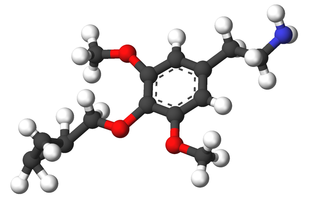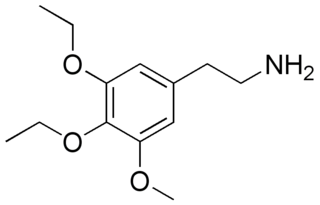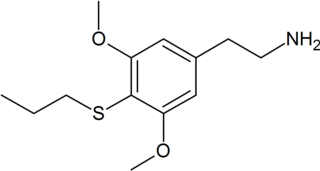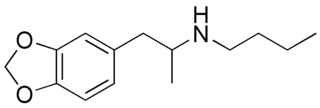
2C-N (2,5-dimethoxy-4-nitrophenethylamine) is a psychedelic phenethylamine of the 2C family. It was first synthesized by Alexander Shulgin.
Trimethoxyamphetamines (TMAs) are a family of isomeric psychedelic hallucinogenic drugs. There exist six different TMAs that differ only in the position of the three methoxy groups: TMA, TMA-2, TMA-3, TMA-4, TMA-5, and TMA-6. The TMAs are analogs of the phenethylamine cactus alkaloid mescaline. The TMAs are substituted amphetamines, however, their mechanism of action is more complex than that of the unsubstituted compound amphetamine, probably involving agonist activity on serotonin receptors such as the 5HT2A receptor in addition to the generalised dopamine receptor agonism typical of most amphetamines. This action on serotonergic receptors likely underlie the psychedelic effects of these compounds. It is reported that some TMAs elicit a range of emotions ranging from sadness to empathy and euphoria. TMA was first synthesized by Hey, in 1947. Synthesis data as well as human activity data has been published in the book PiHKAL.

2,5-Dimethoxy-4-nitroamphetamine (DON) is a psychedelic drug and amphetamine. It is an analog of DOM and DOB. It is also closely related to 2C-N.

2,5-Dimethoxy-4-ethylamphetamine is a psychedelic drug of the phenethylamine and amphetamine chemical classes. It was first synthesized by Alexander Shulgin, and was described in his book PiHKAL.
Ganesha (2,5-dimethoxy-3,4-dimethylamphetamine) is a lesser-known psychedelic drug. It is also a substituted amphetamine. It was first synthesized by Alexander Shulgin. In his book PiHKAL, the dosage range is listed as 24–32 mg. The drug is usually taken orally, although other routes such as rectally may also be used. Ganesha is synthesized from 2,5-dimethoxy-3,4-dimethylbenzaldehyde. Ganesha is the amphetamine analog of 2C-G. It is a particularly long lasting drug, with the duration listed in PiHKAL as being 18–24 hours, which might make it undesirable to some users. It is named after the Hindu deity, Ganesha. Very little is known about the dangers or toxicity of ganesha. Effects of ganesha include:

Aleph is a psychedelic hallucinogenic drug and a substituted amphetamine of the phenethylamine class of compounds, which can be used as an entheogen. It was first synthesized by Alexander Shulgin, who named it after the first letter of the Hebrew alphabet. In his book PiHKAL, Shulgin lists the dosage range as 5–10 mg, with effects typically lasting for 6 to 8 hours.

3,4-Methylenedioxy-N-hydroxyamphetamine is an entactogen, psychedelic, and stimulant of the phenethylamine and amphetamine chemical classes. It is the N-hydroxy homologue of MDA, and the N-desmethyl homologue of MDHMA. MDOH was first synthesized and assayed by Alexander Shulgin. In his book PiHKAL, Shulgin listed the dosage range as 100–160 mg, and the duration as approximately 3–6 hours. He describes MDOH as being very psychedelic and producing increased pleasure in beauty and nature. He also mentioned several negative side effects also seen with MDMA ("Ecstasy") such as difficulty urinating and internal dryness.

3,4-Methylenedioxy-N-propylamphetamine is a lesser-known psychedelic drug and a substituted amphetamine. MDPR was first synthesized by Alexander Shulgin. In his book PiHKAL, the minimum dosage is listed as 200 mg, and the duration unknown. MDPR is a promoter; by itself it has almost no effects on the mind, but it promotes the effects of hallucinogens, similarly to the closely related MDPH.

Cyclopropylmescaline is a lesser-known psychedelic drug. CPM was first synthesized by Alexander Shulgin. In his book PiHKAL, the dosage range is listed as 60–80 mg and the duration listed as 12–18 hours. CPM produces closed-eye imagery, visuals, and fantasies. It also causes enhancement of music. Very little data exists about the pharmacological properties, metabolism, and toxicity of CPM.

Asymbescaline (3,4-diethoxy-5-methoxyphenethylamine) is a lesser-known psychedelic drug. It is a homolog of mescaline. Asymbescaline was first synthesized by Alexander Shulgin. In his book PiHKAL, the dosage range is listed as 200–280 mg, and the duration listed as 10–15 hours. Asymbescaline produces few to no effects. Very little data exists about the pharmacological properties, metabolism, and toxicity of asymbescaline.

Buscaline (3,5-dimethoxy-4-butoxyphenethylamine) is a chemical compound prepared as a possible psychedelic drug. It is an analog of mescaline. Buscaline was first synthesized by Alexander Shulgin. In his book PiHKAL, the minimum dosage is listed as 150 mg, and the duration is "several hours". Buscaline produces no psychedelic or psychoactive effects, but causes heart arrythmia and light diarrhea. It does not cause any visuals or insights. Very little data exists about the pharmacological properties, metabolism, and toxicity of buscaline.

Beatrice is a lesser-known psychedelic drug. It is a substituted methamphetamine and a homolog of 2,5-dimethoxy-4-methylamphetamine (DOM). Beatrice was first synthesized by Alexander Shulgin. In his book PiHKAL, the minimum dosage is listed as 30 mg, and the duration listed as 6–10 hours. Beatrice produces a vague feeling of openness and receptiveness, and causes a stimulative effect. It also causes diarrhea. Very little data exists about the pharmacological properties, metabolism, and toxicity of beatrice.

Allylescaline (4-allyloxy-3,5-dimethoxyphenethylamine) is a lesser-known psychedelic drug. It is closely related in structure to mescaline. Allylescaline was first synthesized by Otakar Leminger in 1972. The compound was later synthesized by Alexander Shulgin and further described in his book PiHKAL. The dosage range is listed as 20–35 mg, and the duration 8–12 hours. Allylescaline produces an entactogenic warmth, an entheogenic effect, and a feeling of flowing energy. Very little data exists about the pharmacological properties, metabolism, and toxicity of allylescaline.

2,5-Dimethoxy-4-ethoxyamphetamine (MEM) is a psychedelic drug of the phenethylamine and amphetamine chemical classes. It was first synthesized by Alexander Shulgin. In his book PiHKAL, he lists the active dose range as 20–50 mg, and the duration as 10–14 hours. According to Shulgin, MEM produces color enhancement, visual phenomena, and pattern movement, among other effects.

F-2, or 6-(2-aminopropyl)-5-methoxy-2-methyl-2,3-dihydrobenzofuran, is a lesser-known psychedelic drug. F-2 was first synthesized by Alexander Shulgin. In his book PiHKAL, the minimum dosage is listed as 15 mg, and the duration unknown. F-2 produces few to no effects at this dose in humans. Animal studies showed it to substitute for the psychedelic drug DOM, but with less than one tenth the potency.

Thioescaline (TE) is a pair of lesser-known psychedelic drugs with the chemical formula C12H19NO2S. They structural analogs of escaline in which an oxygen atom has been replaced with a sulfur atom. They were first synthesized by Alexander Shulgin and reported in his book PiHKAL. Very little is known about their dangers or toxicity.
TOET (methylthio-ethyl-methoxyamphetamines) is a pair of lesser-known psychedelic drugs and substituted amphetamines. 2-TOET and 5-TOET are the 2- and 5-methylthio analogs of DOET, respectively. They were first synthesized by Alexander Shulgin and written up in his book PiHKAL. Very little is known about their dangers or toxicity.

Thioproscaline, or 3,5-dimethoxy-4-propylthiophenethylamine, is a lesser-known psychedelic drug. It is the 4-propylthio analog of mescaline. Thioproscaline was first synthesized by Alexander Shulgin. In his book PiHKAL , the dosage range is listed as 20–25 mg, and the duration listed as 10–15 hours. Thioproscaline causes closed-eye visuals, slight open-eye visuals, and a body load. Very little data exists about the pharmacological properties, metabolism, and toxicity of thioproscaline.

Methylenedioxybutylamphetamine is a lesser-known psychedelic drug. It is also the N-butyl derivative of 3,4-methylenedioxyamphetamine (MDA). MDBU was first synthesized by Alexander Shulgin. In his book PiHKAL, the minimum dosage is listed as 40 mg, and the duration unknown. MDBU produces few to no effects. Very little data exists about the pharmacological properties, metabolism, and toxicity of MDBU.

2C-Se is a lesser-known psychedelic drug. It was originally named by Alexander Shulgin as described in his book PiHKAL. Shulgin considered 2C-Se to be around three times the potency of mescaline, but was too concerned about toxicity to test it extensively, though he considered it noteworthy as the only psychedelic drug to contain a selenium atom.



















